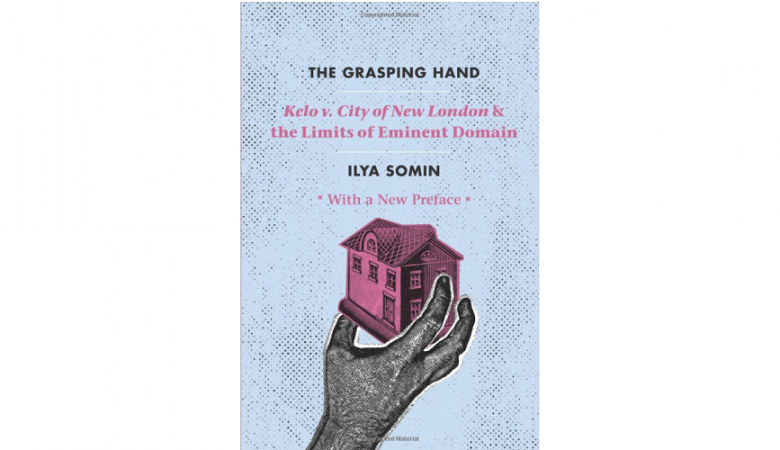PRA Interviews Eminent Domain Expert Ilya Somin
Every government all over the world exercises the power of eminent domain to seize private property, usually justified by the promise of a public benefit. Over time restrictions in the U.S. limiting when and how federal and state governments can use eminent domain have steadily loosened. Property Rights Alliance was happy to discuss use of eminent domain in the United States with Professor Ilya Somin of Antonin Scalia Law School at George Mason University.
Somin is a co-editor of “Eminent Domain: A Comparative Perspective” and authored “The Grasping Hand: Kelo v. City of New London and the Limits of Eminent Domain”. Professor Somin publishes regularly on the Volokh Conspiracy law and politics blog which has recently moved from the Washington Post to Reason magazine. His scholarly work has been featured in the Yale Law Journal, Stanford Law Review, Georgetown Law Journal, and many other publications.
PRA: The 2005 Supreme Court decision in Kelo v. City of New London allowed the local government to transfer property privately owned to another private owner for the purpose of economic development. How does that contrast to use of eminent domain in the 18th century?
Prof. Somin: In the 18th and 19th centuries there was a lot of disagreement on justifiable reasons the government can take property. But the dominant view at the time was that you were only permitted to do so for a “public use” – a publicly owned facility or a privately owned one that had a legal duty to serve the entire public. In the late 19th and even more so in the early 20th century a broader understanding of what constitutes a public use under the federal and state constitutions became more popular.
Many courts, including ultimately the U.S. Supreme Court, came to hold that a public use is anything that might potentially benefit the public in some way, including transferring the property to a private owner who might benefit the community. For example, in the Kelo case they said it was enough if the government just claims it will produce more economic development.
PRA: What was the eminent domain debate around roads and mills in the 18th century?
Prof. Somin: Private roads and mills were the more controversial purposes for which property was taken at the time. There was already a debate between the narrow view of public use and the broader view that defined the concept as any potential conceivable public benefit. Most courts ruled in favor of the narrow view which justified a road only if it was a publicly owned road or a privately owned one which the general public would have a legal right to utilize. That is, the owner could not exclude anyone who obeyed the rules of the road. A mill could be justified only if it was the kind of mill that the general public had a legal right to use, sort of like a public utility. On the other hand, courts often struck down takings for mills when it was a privately owned business and the owner could choose to serve whoever he wanted to accept.
PRA: One of results of Kelo was the renewed vigor in which legislatures passed laws to restrict takings. How effective have legislatures been in curtailing eminent domain?
Prof. Somin: In 2005, the Supreme Court in Kelo v. City of New London ruled that it was permissible to take private property and give it to a new private owner simply on the basis that this might produce economic development. It caused widespread national outrage across the political spectrum. As a result, 45 states enacted eminent domain reform laws. No other Supreme Court decision has ever led to this much state legislation in response. Of the 45 states, there are a good many that enacted laws that actually don’t do much to protect property owners, but there are also 20 or so that really do provide substantial additional protection s. Some of them ban economic development takings and therefore forbid takings that transfer property from one private owner to another simply on the basis of promoting development. Others go further than that and also ban private to private takings on the theory that the land in question is blighted and that a new owner would improve it. Some also increase the compensation that is paid to owners of condemned property.
PRA: Are the legislative reforms restricting eminent domain split between party lines?
Prof. Somin: At least one former Republican National Committee chair thought that the decision was a good idea: Haley Barbour was the former chair of the RNC who later became governor of Mississippi, and as governor he became supportive of these kinds of condemnations. But, Mississippi voters, by referendum, passed a strong reform law that forbade economic development takings in 2011. It is true though there was a lot of opposition by both Democrats and Republicans. Scholars who have tried to research which states were more likely to enact strong reforms did find that Republicans states were a bit more likely, but it’s not a big difference, and there’s a lot of variation.
PRA: Public interest law firms also played an important role in garnering public attention before and after Kelo, will they remain the main avenue for protecting property rights in the future?
Prof. Somin: When it comes to strengthening protections of constitutional rights many say either you should go to court and pursue a judicial strategy, or you should use the political process and pursue a legislative strategy. The truth is, it should not be thought of as an either or proposition. Consider successful reform movements in American history, such as the civil rights movement, the women’s rights movement, the gay rights movement, or the gun rights movement. All of them, generally speaking, engaged in both legal and political action. They found that the two were mutually reinforcing and I think the same is true here.
Going forward, I think we should continue a two-track strategy. There should be targeted litigation with the ultimate goal of overruling Kelo and probably also Berman v. Parker, the 1954 decision in which the Supreme Court first ruled that a public use can be almost anything the government says it is. We should pursue legislative reforms as well. The two are not mutually exclusive. To the contrary, they are mutually reinforcing. We can learn lessons from these previous successful movements and apply them here.
PRA: Economic development hasn’t been the only justification for takings, what are some others?
Prof. Somin: Sure, obviously there are taking for traditional public uses like roads, military bases, schools and so forth. In addition, particularly in the Western states, there’s a tradition of taking property for mines and mining interests. In recent years there’s been controversy over condemnation of property for pipelines and other facilities related to the oil boom of the last several years.
PRA: Closely related to eminent domain are regulatory takings, can regulations ever equate to property seizure?
Prof. Somin: Everyone agrees there is a taking when the government says we’re going to take your land through eminent domain. But, what if the government doesn’t formally indicate they are going to take your land? They are just going to restrict your use of property rights in some way. For example, you are still the owner but you’re not allowed to build anything on your property, or you are still the owner, we’re not taking over your land, but you’re not allowed to build a structure more than 10 ft high. The question is: at what point do such restrictions become so severe that they qualify as a taking that the government is required to compensate you for under the U.S. Constitution? There is a large body of law that tries to answer this question. Frankly it is vague and confusing and has many problems and contradictions in it. The net result is that, in many situations, the government can severely restrict your use of your property rights yet the restrictions are not considered takings. For example, the Supreme Court has said that if the government restricts your property rights so much that it destroys 100% of the economic value of the land in question, then that is automatically a taking. But if they “only” destroy 99% of the value, then a complex three-factor balancing test will be used to determine if it is a taking or not. Most of the time the courts rule that there is no taking.
PRA: Those determinations also come from Supreme Court cases?
Prof. Somin: Yes, the case that says a 100% loss of value is automatically a taking is the 1992 decision Lucas v. South Carolina Coastal Commission. Under this rule the situation is different if it is less than a 100% loss. The three-factor balancing test comes from Penn Central Transportation Co. v. City of New York in 1978. I’ll spare you the details of how it works. But the upshot is that most of the time courts will rule in favor of the government.
PRA: One of President Trumps campaign promises is to build a wall on the U.S.-Mexico border, yet it has been reported that much of the land is privately owned—what are the dangers of how U.S. Eminent Domain law will be applied?
Prof. Somin: It is a bad idea. Obviously, it would result in overriding the property rights of thousands of people, most of them American citizens. It would also require seizing some properties of Native American tribes near the border. The biggest issue involved would be compensation. The Constitution requires just compensation for people whose property has been condemned, which the Supreme Court has interpreted as “fair market value.” But often owners of condemned property do not even get that much. Almost inevitably, there will be legal fights over estimating the compensation for some of those properties.
In other cases, the people may lack the resources for a prolonged legal fight so they might be forced out more quickly. What often happens in these cases is people end up with less compensation than the law requires. And even the legally required compensation often does not compensate people for their full losses because many attach more value to their land than the market price. If they only valued it at the market price, there is a good chance they would have sold their property already. As with a lot of previous takings, there is a high likelihood that if this wall does get built many people would, to use a technical term, get screwed.


